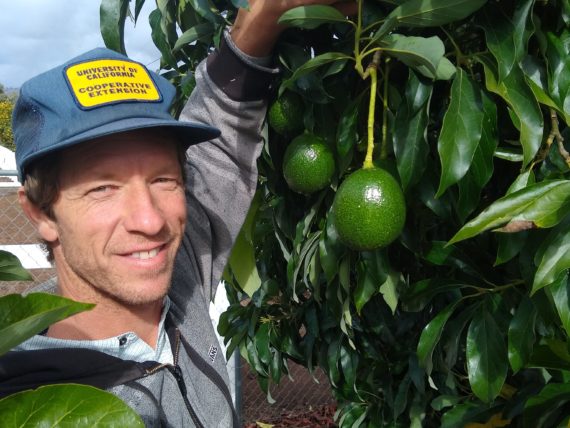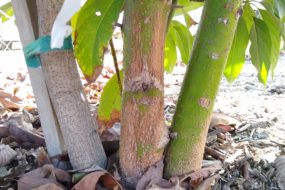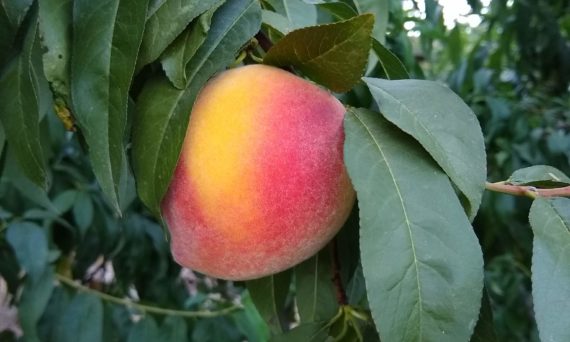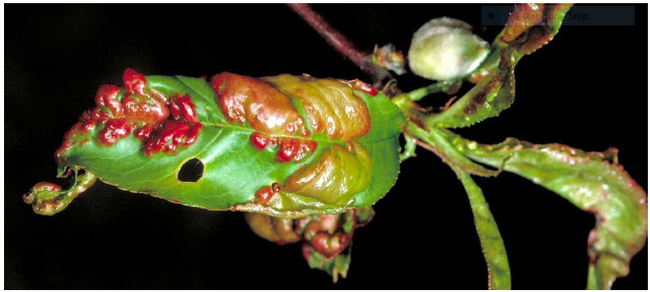Winter Fruit Tree Care

By Greg Alder
Winter is almost here and as temperatures drop it is time for backyard gardeners to start thinking about certain fruit tree maintenance. Attending to the needs of your trees now will improve the health of your plant and promote better flower and fruit production later in the growing season. This does not have to be a time consuming effort if you are organized and know what to look for.
Rootstock Suckers
 Almost all fruit trees are actually two trees in one – the rootstock and fruiting scion. Rootstocks are selected for many reasons, among which are resistance to soil-borne pests and fungi and viral pathogens. The scion grafted atop the rootstock produces better fruit. A Fuji apple tree, for example, is not growing on its original root system but one selected by the grower to better adapt to the area in which it is sold, or to be dwarfing. The point where the scion is grafted onto the rootstock, the union, appears as a swollen ring near the base of the tree. Grafted trees should always be planted with the graft union above ground level. Branches coming from below the union, called suckers, should be removed with hand pruners. Suckers are fast growing and take energy from the tree that is needed for leaf, flower and fruit production. Suckers can grow vigorously and reach a height that could block much needed sunlight to the fruiting scion and would eventually overwhelm the tree. Removing suckers in winter is more easily done with deciduous trees such as stone fruit, apple, pear and persimmon because when the tree’s leaves drop the suckers are easy to see. The drooping branches of evergreen fruit trees, such as citrus and avocado may make it less obvious that there are suckers protruding from the base so look carefully and remove them. Sometimes citrus and avocado may develop what looks like multiple trunks growing at soil level. This is not healthy for the tree and one of the “trunks” is likely a rootstock growth.
Almost all fruit trees are actually two trees in one – the rootstock and fruiting scion. Rootstocks are selected for many reasons, among which are resistance to soil-borne pests and fungi and viral pathogens. The scion grafted atop the rootstock produces better fruit. A Fuji apple tree, for example, is not growing on its original root system but one selected by the grower to better adapt to the area in which it is sold, or to be dwarfing. The point where the scion is grafted onto the rootstock, the union, appears as a swollen ring near the base of the tree. Grafted trees should always be planted with the graft union above ground level. Branches coming from below the union, called suckers, should be removed with hand pruners. Suckers are fast growing and take energy from the tree that is needed for leaf, flower and fruit production. Suckers can grow vigorously and reach a height that could block much needed sunlight to the fruiting scion and would eventually overwhelm the tree. Removing suckers in winter is more easily done with deciduous trees such as stone fruit, apple, pear and persimmon because when the tree’s leaves drop the suckers are easy to see. The drooping branches of evergreen fruit trees, such as citrus and avocado may make it less obvious that there are suckers protruding from the base so look carefully and remove them. Sometimes citrus and avocado may develop what looks like multiple trunks growing at soil level. This is not healthy for the tree and one of the “trunks” is likely a rootstock growth.
Pruning
 Winter is also a great time to do general pruning on fruit trees. Remove dead branches and any that cross over their neighbor. This would also be the time to make fruit trees smaller or more balanced. Keep in mind that any mango, avocado or orange fruits growing fifteen feet up a tree is less likely to be harvested than one growing five feet off the ground. Be aware of your microclimate when deciding when to prune frost-sensitive trees like mango, orange or avocado. These fruit trees grown in areas that do not frost over in the winter, such as along the coast are safe to trim once the temperatures drop. San Diego orchardists who live inland, in the mountains or any area that receives frost, should wait until after the last frost to prune. Those that grow fruit trees in areas that receive frost may have to wait as long as March to manicure their trees.
Winter is also a great time to do general pruning on fruit trees. Remove dead branches and any that cross over their neighbor. This would also be the time to make fruit trees smaller or more balanced. Keep in mind that any mango, avocado or orange fruits growing fifteen feet up a tree is less likely to be harvested than one growing five feet off the ground. Be aware of your microclimate when deciding when to prune frost-sensitive trees like mango, orange or avocado. These fruit trees grown in areas that do not frost over in the winter, such as along the coast are safe to trim once the temperatures drop. San Diego orchardists who live inland, in the mountains or any area that receives frost, should wait until after the last frost to prune. Those that grow fruit trees in areas that receive frost may have to wait as long as March to manicure their trees.
Mulching
A 2-4 inch layer of brown leaf material or small wood chips placed under a fruit tree will produce great benefits over time. Mulch suppresses the growth of weeds that germinate with the winter rains, conserves soil moisture, reduces rain and irrigation runoff, moderates soil temperature, reduces soil compaction, and breaks down to feed the bacteria in the soil whose byproducts, in turn, fertilize the tree naturally. It is best to wait until there has been enough rain to soak the soil under the trees before applying the mulch. Subsequent rainfall will saturate the mulch layer and later allow water to infiltrate the soil below. In the spring the soil below the mulch will remain moist for a surprisingly long time and the trees won’t need to be watered until drier weather comes. Be sure that the mulch is not directly against the tree trunk.
Dormant Spraying
 Peach leaf curl is caused by a fungus that affects peach, ornamental peach and nectarine trees and is a very common problem. The reddening and eventual puckering of the leaves becomes evident in the spring. Peach leaf curl rarely affects the fruit, but problem trees can be sprayed with a fungicide in the winter when the branches are bare. This has to be done every year and if it is a wet winter a second application may be necessary late in the dormant season. For more information see the UC IPM Pest Note “Peach Leaf Curl" http://ipm.ucanr.edu/QT/peachleafcurlcard.html
Peach leaf curl is caused by a fungus that affects peach, ornamental peach and nectarine trees and is a very common problem. The reddening and eventual puckering of the leaves becomes evident in the spring. Peach leaf curl rarely affects the fruit, but problem trees can be sprayed with a fungicide in the winter when the branches are bare. This has to be done every year and if it is a wet winter a second application may be necessary late in the dormant season. For more information see the UC IPM Pest Note “Peach Leaf Curl" http://ipm.ucanr.edu/QT/peachleafcurlcard.html
Greg Alder has been a UCCE Master Gardener since 2012. He lives in Ramona, where he has space to provide his wife and three children with most of their fruits and vegetables, plus grow a few dozen varieties of avocado.

